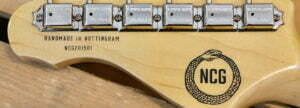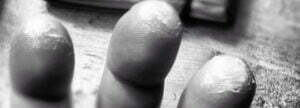Electric guitar tone wood – a myth, complete tosh. Believed by those who have bought in to it, probably at great expense.
Bit of a sweeping statement. An electric guitar works on basic electro-magnetic principals, school boy physics. No amount of vibrating wood is going to add anything positive to the experience. The instrument was fundamentally designed to be plugged in and played loud. Not strummed, unplugged, in the dead of night.
It all harks back to those heady days when Fender and Gibson moved in to commercial production, and direct competition, of electric solid body guitars.
Gibson had been producing high quality instruments for years. Often using mahogany – quite possibly because it was deemed to be a “quality, expensive timber befitting the product” and probably because a lot the craftsmen were from the furniture business and familiar with using mahogany.
Along comes Leo Fender with his poor man’s Broadcaster. Do you seriously believe Leo went around tapping trees and planks? No, he probably made his first batch of bodies from off-cuts scrounged at the local wood yard, carried away in a sack. And quite a lot more the same way there-after.
Both the big names knew how to sell and what was required from their product.
So, you have decided, God knows why, to buy a brand new guitar. Wander in to PMT or Guitar Centre, those guys do it really well. 1000’s of brand new shiny guitars to choose from. You have probably already decided on a brand and model before entering the shop. First choice, off the wall, 95% mind made up, is down to colour, then weight, how it feels and how it plays unplugged – Why ???? and finally, last of all, plug it in and play. What a strange sequence of events choosing a musical instrument.
So, the chosen “tone wood” must look great and / or be able to receive a paint finish. It must machine well, not produce too much waste, be stable and readily available in certain section sizes, not too heavy or expensive – nothing to do with tone there.
Resonate is a misused word. The frequency of a resonating object is a function of the material and its structural form and dimensions – think slender. The Tacoma Narrows Bridge resonated most spectacularly. Google that if you have not seen it. Wood does not resonate. Certainly not slabs 40 mm thick with just the input of a plucked string. A guitar body and neck will vibrate ever so slightly when a string is plucked, but at a minute level, barely audible. This vibration cannot be detected by the guitar pickup, it may not even be in sympathy with the string wave form. It could act negatively and ultimately detract from the pickup’s output.
However Fender and Gibson had this problem covered. To prevent these miniscule, but UNWANTED wood vibrations, they introduced rudimentary damper systems for the pickups, springs and bits of rubber tubing. To isolate even further, many pickups were then suspended in a plastic ring or sheet. We don’t want any tone creeping in to that wood.
Now tell me, does anybody wax lyrical about the tonal properties of vintage plastic pick guards, pickup rings and wood screws ? – No.
In order for a guitar string to sustain and generate a high output, the string must vibrate for longer at a greater amplitude. String energy must not “leak” in to the body wood and cause the wood to vibrate, thus reducing the available string energy.
In short, the magical guitar “tone wood” must reject string vibration. This is achieved by increasing body density. An ideal body material in this respect would be concrete or granite.
Ted McCarty credited the Les Paul’s maple cap to Les, who insisted that maple increased the density of the mahogany body – which it clearly does, maple is relatively very heavy, and hence this increased sustain. Interestingly they slapped gold paint all over it and were not too concerned with showing off the grain. Les knew his stuff, very clever bloke. I reckon Les and Leo nicked a lot of ideas off Paul Bigsby, but that’s another story. All three came up with some great ideas and strangely, pretty much got it right first time round. If only things had been left alone…….
In the Gibson factory new fangled electrified hollow bodies were fitted with heavy centre blocks to prevent unwanted body vibration affecting the pickup and to increase body density. Sought after vintage ES 335’s were, and still are, manufactured from plywood – a great tone wood ? Veneer lovingly carved from the Tone Wood Tree ? Glued together with Fairy glue ? They make boats from plywood and small aeroplanes.
I have stripped the finish from Fender guitars and seen bodies glued together from up to nine separate pieces of wood – like an Ikea bread board, but you would never know when played.
Vintage lap steels – sound great, but made from any old base board, not even always wood. They don’t vibrate. But the pickups have been hunted down, scavenged, butchered and stuck in many Tele’s, emulating Keith Richards. Try finding a 50’s Fender Champ with original pickup.
The guitar is a composite structure and must be stiff and rigid. The ability to accept and hold screws, bushes and bolts is of great importance – so a hard, dense wood will always be more suitable and have no direct bearing on the tone of sound produced.
Here’s the sales pitch – check out the aluminium NCG Moneymaker.
Aluminium is very stable and provides a great degree of sustain. I doubt in a blind test that anyone could tell the difference, with similar pickups, between a vintage ash Tele, a James Trussart steel Telecaster, an aluminium NCG Moneymaker, an alloy Travis Bean or an acrylic Dan Armstrong.
They do however all feel slightly different. Guitars are very tactile. Vintage instruments tend to have very thin finishes and often feel slightly different compared to a new guitar of the same model – but that strays away from the subject of tone and slips in to the field of desirability.
While my comments absolutely refer to electric guitars, Taylor proved a point with their pallet guitar, made from, as you may expect, an old pallet from their yard. Taylor’s argument being it was more down to workmanship than quality of wood. The guitar performed admirably, rusty nails, holes and all.
And while we are at it, to de-bunk another myth – wood does not breathe. The tree ceased to breathe when the chainsaw bit. Logged timber is rough sawn, seasoned to a suitable moisture content, ideally for many years and then planed to finished size. Kiln drying may speed up the process. Guitar bodies are finished with clogging, highly toxic solvents and paints – not much breathing going on there.
If your guitar body breathed, there would be something very weird happening and it would invariably change shape with the weather.
It’s strange how so many want to emulate the great players, maybe a natural thing. In their day the majority were not playing vintage instruments, as they were new (ish) at the time. Age catches all, pickup magnets change, capacitors drift from appointed values, strings were different. Pot’s and looms were different. Guitar leads were probably cheap and nasty bell wire – now there’s a thought.
So, sadly it’s all emperor’s new clothes and ultimately down to your fingers – don’t blame the wood.


